There are two types of NFT marketplaces: primary marketplaces and secondary marketplaces.
Unlocking the World of NFT Marketplaces: Everything You Need to Know

2 min read
19 April 2023
With the rise of blockchain technology, a new type of asset has emerged: Non-Fungible Tokens (NFTs). These digital assets represent unique items such as artwork, music, and other creative works. NFTs are becoming increasingly popular, with the market expected to reach $1.5 billion in 2021 alone. NFT marketplaces are the platforms where buyers and sellers of NFTs come together. This article will explore what NFT marketplaces are, how they work, and what makes them unique.
What are NFT Marketplaces?
NFT marketplaces are online platforms where buyers and sellers of NFTs can come together to buy, sell, and trade digital assets. NFT marketplaces have become increasingly popular due to the rising demand for NFTs. These marketplaces allow artists and creators to monetize their digital creations by selling them as NFTs. NFT marketplaces have become a significant part of the art and collectibles industry.
How do NFT Marketplaces Work?
NFT marketplaces work by allowing users to create and sell NFTs. Buyers can purchase NFTs using cryptocurrencies, such as Ethereum. NFT marketplaces use smart contracts to facilitate transactions. Smart contracts are self-executing contracts that automatically enforce the terms of the agreement between the buyer and seller. These contracts ensure that the transaction is secure and transparent.
Types of NFT Marketplaces
There are two types of NFT marketplaces: primary marketplaces and secondary marketplaces.
1. Primary Marketplaces
Primary marketplaces are where NFTs are initially sold by the creator. These marketplaces allow artists and creators to sell their digital creations directly to buyers. Primary marketplaces take a percentage of the sale as a commission. Eg: Rarible
2. Secondary Marketplaces
Secondary marketplaces are where NFTs are resold by buyers. These marketplaces allow buyers to purchase NFTs that are no longer available on primary marketplaces. Secondary marketplaces take a percentage of the sale as a commission. Eg: OpenSea, Jump.trade
Conclusion
NFT marketplaces are becoming a significant part of the art and collectibles industry. These marketplaces allow artists and creators to monetize their digital creations and offer buyers a way to invest in unique assets. While there are challenges facing NFT marketplaces, such as scalability and regulation, the potential benefits are significant.
In case you have found a mistake in the text, please send a message to the author by selecting the mistake and pressing Ctrl-Enter.

No comments yet